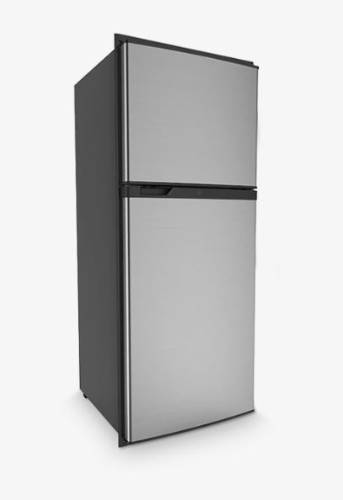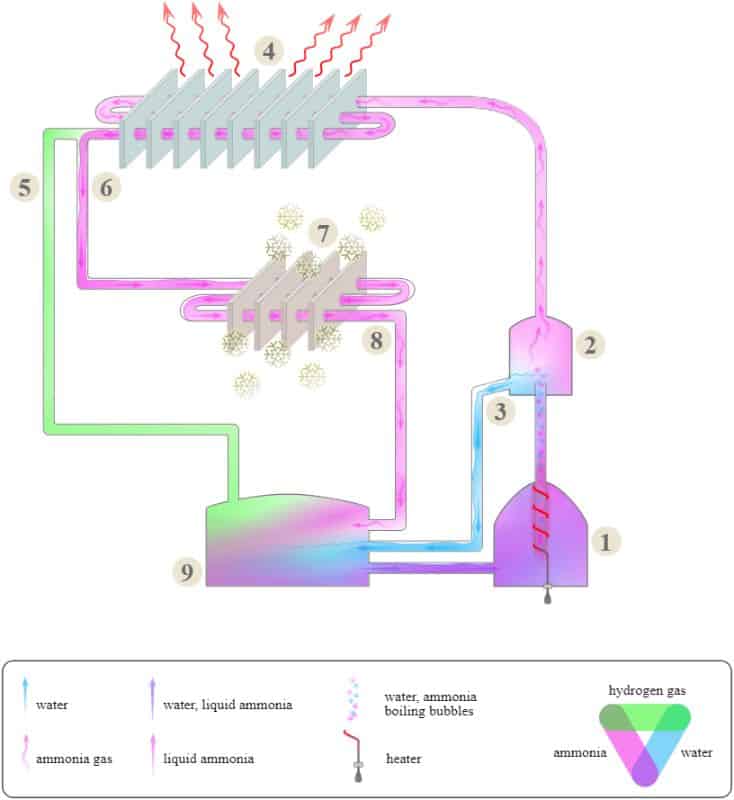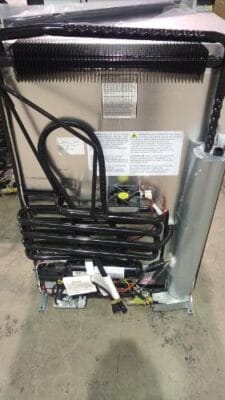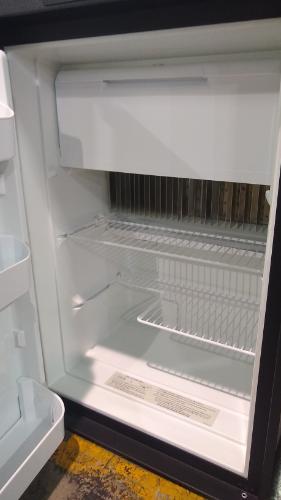Isn’t your home fridge wonderful? It’s as silent and reliable as a British soldier in the Queen’s Guard. No obnoxious beeps. No 20-page instruction manual. No indecipherable electronic hieroglyphics. It gets cold, then stays cold.
I’m betting you haven’t enjoyed the same leisurely, no-strings-attached relationship with your RV refrigerator.
- Maybe wasps took up residence in the absorption coils.
- Maybe it just … won’t …. get …. COLD!!
- Maybe you’re camping in the Colorado mountains, and the d**n thing doesn’t even have the decency to turn on.
Whatever your problem, I’m sorry. RV refrigerators can shave several years off your life. But you can’t live without one. No fridge = no ice cream, no booze, and warm pickles. And is camping even worth it without ice cream?
I’ll help you understand your fridge frienemy.
I’ll introduce you to 12V fridges and residential-style compressor refrigerators, but the bulk of this article is about absorption refrigerators. These are the de facto standard in almost all RVs built today and over the last several decades.
What Are the 4 Types of RV Refrigerators?
RVs have one of three types of refrigerators:
- 12V fridge/freezer*
- 12V Compressor refrigerator
- AC Compressor refrigerator
- Absorption refrigerator (commonly called 2-way or 3-way fridges)
*Technically, a 12V fridge/freezer is a type of compressor refrigerator. But it’s easiest to assign the type its own category.
1. 12V Fridge/Freezer
No, I’m not talking about one of those $100 “12V coolers” you find on Amazon.
Those products are thermoelectric coolers. They are not true fridges/freezers. Think of them as chillers, not fridges. They cannot maintain 40 degree (fridge) or 0 degree (freezer) temperatures. They also draw a lot of power, so they can only be operated while plugged into the outlet of a running vehicle. That’s why you don’t find them in RVs.
No, I’m talking about compressor 12V refrigerators. I’ll further break down this category into portable fridge/freezers and stationary 12V fridges.
Portable 12V Fridge/Freezer

These wonderful inventions are capable of maintaining true fridge and freezer temperatures. They typically run on either 12V or 120V power – and they are incredibly efficient.
They draw no more power than an incandescent flashlight, typically less than 1 amp @ 12VDC when in holding mode.
Popular brands include:
- Dometic
- ARB
- Engel
- IceCo
12V fridge/freezers are commonly used in van conversions, off-road expedition campers, teardrop campers, and small Class B vans.
They are an excellent design choice for small spaces, rough terrain, and boondocking. They are the ONLY type of fridge that can realistically be powered by one or two 12V batteries.
Due to their size (tiny, typically the size of a 50-quart icebox or smaller) and price (very high, usually $500 – $1,200), these refrigerators are not seen in mainstream RVs.
Full-Size 12V Fridge/Freezer

These fridges are rather recent innovations. Popular brands include:
- GE
- Furrion
- Everchill
- Novakool
- Vitrifigo
Just like your home fridge, these units operate on the vapor-compression cycle. They are extremely quiet and reliable.
The big difference is they run only on 12V power. They use premium high-efficiency Danfoss compressors, very similar to what’s used in their smaller cousins.
There’s a lot to love about these fridges.
- Extremely energy-efficient!
- Lighter weight than a typical fridge
- Consistent storage temperature
- No exhaust fumes
- More space than comparable absorption fridge
However, due to their larger size (6-12 cubic feet), they still draw a LOT more power than a portable fridge. A compact portable unit might draw less than 1 amp; an 8-cubic foot 12V fridge might draw 3-5 amps. If the fridge has an average 20 percent duty cycle, that’s 14.4 – 24 amps per day. Not too bad!
But … they aren’t cheap. $1,200 and up. A $2,000 ballpark is typical. And you need a battery bank of at least 200Ah.
So you won’t see a 12V fridge in a mainstream travel trailer. They are used on high-end RVs designed for boondocking and off-grid camping. You’ll also see them used on all-electric RVs that don’t even have a propane system!
2. Residential Compressor Refrigerator
I’m not going to spend much time on this fridge. You’ve used this type of fridge every day of your life. You know how it works.
Unfortunately, they’re power hogs. A typical residential fridge can use 2,000 watt-hours of energy in a day. You’d have to be plugged into shore power 24/7!
So you won’t find these relocated residential fridges anywhere besides mobile homes, park models, and Class A coaches with giant battery banks and built-in generators.
2. RV Absorption Refrigerator

Alright. We’ve passed the opening act; it’s time for the star of the show: the absorption refrigerator.
Popular brands include:
- Dometic (who purchased ElectroLux and Atwood)
- Norcold
The standard RV refrigerator operations on an absorption cycle. An absorption refrigerator isn’t a typical refrigerator. It doesn’t have the same mechanical innards as a regular residential refrigerator.
It sounds backward, but the fridge needs a source of heat in order to cool! It either needs a propane burner flame or an electric heating element.
An RV fridge goes through three main stages:
- Evaporation
- Absorption
- Regeneration
You can see the full process illustrated below. (If this image gives you heart palpitations, don’t worry. The rest of the article won’t be so science-y.)

Meet the Key Players
Meet the four key players:
- Ammonia: working refrigerant, responsible for the magical cooling
- Water: absorbent, responsible for capturing and dissolving gaseous ammonia
- Sodium chromate: rust inhibitor, can cause pesky clogs if it crystallizes
- Hydrogen gas: thanks to partial pressures, it lowers the evaporation temperature of the ammonia well below the design temperature of the freezer/refrigerator.
It’s actually pretty ingenious! When working properly, the cycle requires no moving parts: just the liquids and a source of heat. And the system is completely closed, meaning that the refrigerant is constantly recycled; nothing wasted.
How an RV Absorption Refrigerator Works
If you’ve looked at the back of your RV refrigerator, it’s a labyrinth of black tubes, fins and coils. Here’s what’s really going on back there!

- A burner flame or heating element in the boiler supplies heat to a 2-part strong solution of ammonia (refrigerant) and water (absorbent), causing the ammonia to boil.
- The hot vapors rise through a percolator tube into a separation chamber (aka, the rectifier), where any water vapor cools and condenses into a liquid. This weak water-ammonia solution then drains into the top coils of the absorption chamber (see Step 5).
- Meanwhile, the hot ammonia gas rises into a series of finned condenser coils, located at the top of the back of the refrigerator. Heat is dissipated to the outside air, which is then exhausted out of the refrigerator sidewall or roof vent. The ammonia, now cooled, turns back into a liquid.
- After being exposed to hydrogen-ammonia vapor, the liquid ammonia drains through the low-temperature (freezer) and high-temperature (refrigerator) evaporator coils, where it expands in the presence of hydrogen. This phase change absorbs latent heat from the fridge and freezer compartments, cooling them down. That’s where the magical cooling happens.
- After the ammonia-hydrogen gas travels through the evaporator, it returns to the absorption chamber. It rises through the absorber vessel coils, where the water solution from Step 3 absorbs the ammonia vapor, rather like a sponge, and returns it to the absorption chamber, leaving only pure hydrogen to rise back to the evaporator for Step 4.
- The process repeats from Step 1.
If you crave more science, then I invite you to read my in-depth super-nerd answer to how an RV absorption refrigerator works.
The RV Owner’s Essential Fridge Takeaways
Ok, so you don’t need to understand what latent heat of vaporization is to get a handle on your RV fridge. Basically, a heating element vaporizes ammonia, and the system works its magic from there.
So yes, you need heat in order to freeze your food. ENGINEERING IS SO COOL!
But the system has some weak points, things that you might not expect from a fridge. You should understand these concepts in order to properly use and troubleshoot your RV fridge.
1. Operates on Gravity

The system only works because hot gases rise and liquids fall. If your RV is off-level, this will affect how quickly the gases and liquids move. If, say, your liquids linger too long in the boiler, you’ll overheat the system, which can cause permanent damage.
Leveling your fridge is CRITICAL!* However, you get some leniency if you’re operating the fridge in a moving vehicle, such as a motorhome. Dometic says:
“When the vehicle is moving, the leveling is not critical, as the rolling and pitching movement of the vehicle will pass to either side of level, keeping the liquid ammonia from accumulating in the evaporator tubing.”
Again: You must understand this idea of leveling! Because the system runs off gravity, being off level will affect performance. That quite literally means that a fridge tilted at 3 degrees WILL NOT COOL AS QUICKLY as a fridge tilted at 0.5 degrees.
So if your RV fridge isn’t cooling as well as you’d like, your first step should be to ensure the fridge is level or close to it.
2. System Is Pressurized
Parts of the system are pressurized to more than 300 psi (that’s 4-5x your tire pressure)! The tiniest hole or crack will eventually fail under those pressures. That’s why even minor rust or damage to tubing can cause a catastrophic failure. If you see greenish or yellowish residue on the floor, that’s a sure sign of a failed cooling unit. That’s sodium chromate where it doesn’t belong.
3. Exhausts Heat and Fumes
All that heat from your fridge’s interior has to go somewhere! And when burning propane, the fridge releases toxic exhaust gases, too. You don’t want either of those things inside your RV. That’s why your RV is installed inside a sealed compartment and the hot gases are exhausted through your fridge vents.
4. Doesn’t Cool Quickly
– or too accurately, for that matter. You can’t likely maintain your fridge compartment at 38 degrees and your freezer compartment at 0 degrees, like you would in your house. The temperatures will ebb and flow, rise and fall. Daily changes in outdoor temperature can have a major effect.
You cannot change this fact. It doesn’t matter how tuned up your fridge is – if it’s 98 degrees outside, your fridge compartment won’t cool all the way to 38 degrees within 30 minutes. That’s just a fact of life with this type of fridge.
5. Doesn’t Cool Consistently
As a rule of thumb, an absorption refrigerator will cool the:
- Freezer compartment to 40-50 degrees below ambient temperature
- Fridge compartment to 25-40 degrees below ambient temperature.
If you’re counting your fingers right now, you’ll have already spotted the problem with this math. At home, a freezer is supposed to maintain 0 to -10 degrees; a fridge, 35-40 degrees.
So you won’t get consistent cooling out of an RV fridge. And in fact … the hotter the outside air … the worse it gets. Some RV refrigerators are known to offer rather poor cooling performance in temperatures hotter than 85-95 degrees. In fact, many RV owners resort to using ice packs from their home refrigerators to “help along” their RV fridges.
6. Requires Electricity to Operate
Many RV refrigerators are designed as “3-way” refrigerators, meaning they can operate off of 12V DC (battery) power, 120V AC (shore) power, or propane.
2-way refrigerators can typically only run on propane and 120V AC power, not battery power.
Now, it’s pretty cool that a fridge can run off a flame! That’s one of the reasons why the industry has stuck with the absorption refrigerator for so long, despite its faults.
However, don’t assume that you don’t need any power whatsoever. Almost all refrigerators require at least some electricity to operate the internal electronic controls. Most Dometic refrigerators, for instance, will shut down if the supply voltage falls below 9.6V.
7. Runs Best on Propane
An important takeaway is that you don’t get equivalent cooling performance out of all the operating modes.
- Propane provides the best cooling, but performance will vary depending on altitude.
- 120V AC electricity provides consistent cooling, but you must be connected to shore power (or have a very large inverter).
- 12V DC electricity will not cool your refrigerator! It only helps maintain temperature; it won’t cool down the chicken breasts you just bought.
I want to highlight and reiterate that third point – if you run your RV fridge off your battery, you will drain the battery very quickly! See the FAQs for more information.
8. Doesn’t Work Well in High Altitude
There’s a dirty little secret about propane-powered refrigerators that many RVers don’t learn until it’s too late: They don’t work well (if at all) at high altitude.
- Expect a moderate performance decrease 5,500 – 8,000 feet.
- Expect significant performance decrease (or problems operating) between 8,000 and 10,000 feet.
- Above 10,000 feet, all bets are off. You may find it difficult (or impossible) to keep the burner even lit!
These elevation ranges are estimates. Ambient temperature and humidity have a significant effect. So does the fridge make and model; some run just fine at 8,000 feet. Others will struggle to even light the pilot flame!
You might be able to purchase a high-altitude burner orifice to assist with propane combustion at higher elevations. Otherwise … may I suggest you bring an icebox?
RV Absorption Refrigerators Do’s and Don’ts
Do’s
- Do level your RV! There should be no noticeable slope or slant.
- Do start your RV fridge at least 12 hours before beginning a trip.
- Do bring along 2-3 ice packs to help keep the fridge cool.
- Do check on the evaporator fins frequently to ensure they are defrosted.
- Do ensure that the fridge vents aren’t clogged with bugs, dirt or debris.
- Do keep the sidewall of the RV with the fridge in the shade.
- Do keep a fridge/freezer thermometer to check on compartment temperatures.
Dont’s
- Don’t store hot food in the fridge. Let it cool first!
- Don’t stuff the fridge! Give the air room to circulate.
- Don’t open the door to food-gaze. Keep it closed! Ensure the gaskets seal tightly.
- Don’t operate the fridge if your camper is off-level more than 3 degrees.
- Don’t block the fridge vents! You may even consider installing some extra 12V vents to accelerate airflow.
- Don’t let your fridge sit unused for long periods of time. Run it often. This prevents sediment buildup.
FAQs about RV Refrigerators
Can You Run the RV Fridge Off the Battery?
As a rule, the answer is no. Your typical RV-off-the-sales-lot doesn’t have a big enough battery bank to run the fridge. You’ll drain your battery and shorten its lifespan.
There are three exceptions to this guideline.
- If you have a large battery bank, large inverter, and efficient electric fridge, then yes, you can run your RV fridge off your house batteries. But you should calculate or measure how much energy it will take!
- If you have a coach or motorhome, you can run the engine to power the alternator to charge your house batteries. Obviously, this is a big waste of gas.
- With any RV, you can run a generator to charge your batteries. But again, this is usually a big waste of power, especially just to run a fridge.
Can You Run the RV Fridge While You Drive?
Yes! Kinda. Well, it depends. Again, most RV fridges need shore power, battery power, or propane in order to function. While traveling, you obviously don’t have shower power. And as I explained above, most fridges will quickly drain your house battery bank.
If you’re towing, then theoretically the umbilical cord between your tow vehicle and camper will provide the power to operate the fridge. But in practice, a tow vehicle connection rarely provides enough juice to run a fridge. It still drains the batteries.
So most RVers with towable campers either turn off their fridges while in transit, or (gasp) they run the fridge on propane while traveling.
If you’re driving a motorhome, then you’re in luck! The alternator will supply consistent 12V DC power to the fridge, and you can drive to your heart’s content.
Why Are My Evaporator Fins Frozen?
Most RV refrigerators don’t have a dedicated defrost cycle. If you camp long-term in your RV, eventually, you’ll probably have frozen fins.
The manufacturer’s recommendation is to turn off the fridge and wait for the fins to defrost, but who wants to wait another 6-12 hours for the fridge to cool back down?
A common DIY solution is to defrost the fins with a hair dryer (don’t get too close). Or you can scrub them with a soft-bristle brush.
Why Won’t My Propane Light?
If your fridge won’t work on LP operation, you may have one of several problems.
- You have a bad thermocouple. This sensing tool detects a flame, signaling successful combustion, and alerts the control board.
- You have too much air in the propane lines. When an RV sits for a long time (or is brand new), air can settle in the propane lines. So what you think is propane coming out of the burner is just air! Bleed the system by opening up the stove burner and allowing air to escape until the stove burner lights.
- You’re at a high altitude. Some propane burners have a hard time staying lit above 6,000-10,000 feet. Solution: If your fridge comes with an air adjuster, adjust it to the proper setting for your elevation.
- You have a bad regulator. If your system propane regulator has gone bad, it may not be allowing enough propane to pass through the manifold to maintain 11″ WC of pressure.
- Your fridge burner orifice is clogged. If you think you might have a clogged orifice, you should soak the orifice for a few minutes with an alcohol-based solvent. Don’t insert anything into the orifice besides a single soft bristle.
Other palm-to-face root causes could be that you simply ran out of propane or you forgot to twist the propane tank valve to OPEN.
Why Is There Yellow Residue Around My Fridge?
If you see any yellowish liquid or stains around your fridge (check in the back, behind the wall vents), then the worst has happened. There’s a good chance you have an ammonia leak. What you’re seeing is sodium chromate from the solutions inside.
Other symptoms include a hot boil but cold absorber and a strong fishy, sulfurous smell coming from the refrigerator compartment.
If you have a leaking cooling unit, be prepared to purchase a new fridge. Replacing or fixing a cooling unit may cost more than a new refrigerator.
RV Refrigerator Owners Manuals
Love it or hate it, your fridge is here to stay (unless you’re in the mood for a $1,200 – $3,000 DIY mod, of course). Get some ice cream and enjoy it. (Better enjoy it quickly, because RV fridges aren’t known for keeping ice cream solid for very long!)
If you want to learn more about RV absorption refrigerators, you can actually read the Dometic fridge technical diagnostics manual here.
Dometic and Norcold are the only two major North American manufacturers of absorption refrigerators. If you’re looking for a new fridge, or you’re seeking documentation, visit their websites here.
Leave a Reply